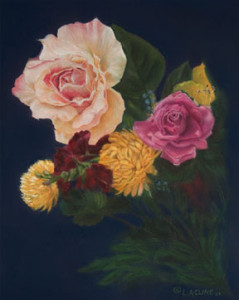Oil Painting
Oil painting has been the traditional medium used for most portrait, florals and scenery paintings. Oil can produce very realistic and luminous effects using the right mixture of colors to achieve the brightness and shadowing of color. It was the choice for painters when invented in the 15th century by the Flemish, Italian and Venetian Painters.
Pastel Painting
The history of Pastels centered around France with Venice artist Rosalba Carreira born in 1675 the first popular painter who created art with pastel. Edgar Degas 1834-1917 took pastel and explored new techniques that really brought pastel to the forefront. Pastel became another choice that is as wonderful as oil. With the advent of modern technology such as Acid-Free Cotton papers mounted on an Acid Free surface, museum glass with UV protection that is hardly noticeable has increased the permanence and longevity of pastel paintings to the levels attributed to oil paintings. Unlike oils that use pure pigment and oil to bind the colors, pastels use pure pigments mixed with small amounts of binder such as gum arabic that are rolled into sticks and dried. The incredible thing about pastels is that you can achieve the same boldness in color as in oil paintings because pastels are a very pure pigment with a high degree of permanence made with very little binder. The look is softer more natural with pastels because of the powered finish of the medium, yet the colors are as grand as the color of oils.
Both Mediums
Both mediums start with the same pure pigment, one is wet and one is dry. They both have their “enemies.” Oil has a tendency to crack or dry out with age and the linen may stretch-out or wear at the points of stretching. Sometimes the glazes on oil paintings make it harder to see the image in bright light. These glazes are sometimes delicate and do in time react to light. Pastel paintings must not be touched and must be framed with glass and are usually sprayed. Water can damage the painting. Oil paintings are usually framed, but not usually, with glass. Now we have museum glass “True View” that truly allows you to view the pastel painting hardly noticing the glass that protects the art from damage and UV rays.
Realistic oil paintings have a luster to them and Pastel Paintings have a soft, more realistic, powdery look. Both mediums should be placed in a cool room with soft lighting, nothing directly shining on the painting.
L.A. Cline’s Pastel Paintings
When I create my Pastel Paintings I build the light into the painting using layers of colors. I work in the morning, afternoon, evening light, on sunny and cloudy days. This way my works change with the lighting of the day and look great throughout the day into the evening, with soft lighting that is already established in the room.
It is very important that you start a custom painting and leave plenty of time before it is expected to be completed especially if it is for a special occasion. It is customary to start a painting at least 6 months before the event and more if it is a large piece.
The Pastel palette has changed so much that I am amazed at the bright and light color combinations I can create. I use at least 15 to 20 layers of pastel to build the color I need for each Masterpiece Pastel Painting. After over 30 years of creating Pastel Paintings I know this medium produces the most beautiful effects with all types of subjects.
Written by: L.A. Cline. Master Pastel Artist
About the Author
L.A. Cline, has been a Master Pastel Artist for over thirty years, commissioned to create custom Fine Art Pastel paintings that include; Corporate portraits, Family and Pet Portraits and Memorial Portrait paintings. The Artist has created collections of Nature Paintings that include; Landscape paintings, Floral paintings, Wildlife paintings, a gallery of Sports Athletes and Entertainment paintings and so much more. The Sports Collection has been featured on ABC’s Channel 10, South Florida Sun Life Football Stadium and the BB&T Hockey Arena in Florida. The Artist is also a member of the Pastel Society of America, New York City.
The Artist has two Giclee Reproductions of Memorial Corporate Pastel Paintings, Judge Aronovitz and Judge Lawson E. Thomas at the Smithsonian Institute, Washington DC, in the American Art and Portrait Gallery Library, “Living Artists File.” This file can be viewed by the public to learn about our American Heroes and the Artists that created their image. This file also allows visitors to see the Artist works as a recommendation for future commissions.
In January 2014, L.A. Cline was voted the “People’s Choice” award at the Lauderdale Yacht Club 7th Annual Fine Art Show.
Contact Information:
www.LACfineart.com
LAC@LACfineart.com
954-850-1056
